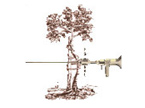Normal knee function requires a smooth gliding articular cartilage surface on the ends of the bones. This surface is composed of a thin layer of slippery, tough tissue called hyaline cartilage. This cartilage also acts to distribute force during repetitive pounding-like movements such as jumping or running.
Injured Cartilage:
A severe knee cartilage injury can radically change an active adult’s lifestyle. Symptoms such as locking, catching localized pain and swelling often affect your ability to work, play, even perform normal activities.
A cartilage lesion appears as a hole or divot in the cartilage surface. Since cartilage has minimal ability to repair itself, even what may seem like a small lesion (ranging from the size of a dime to a quarter), if left untreated, can hinder your ability to move free from pain, and cause deterioration to the joint surface.
Treatment with Autologous Chondrocyte Implantation (ACI):
Although cartilage in unable to repair itself on its own, advanced FDA-approved technology allows cartilage cells, know as chondrocytes to be harvested from your knee and cultured and multiplied. The fresh chondrocytes are then reimplanted in your knee and cause hyaline cartilage to regenerate. This biological repair is known as ACI. When you successfully complete ACI and rehabilitation, you should be able to resume all normal activities, including sports.
ACI, also known as Carticel treatment, restores the articular surface and regenerates hyaline cartilage without compromising the integrity of healthy tissue or the subchondral bone.
Carticel has demonstrated important benefits in patients with a type of lesion called a femoral focal lesion. If your orthopedic surgeon has determined that you have this type of lesion, then Carticel may be an appropriate treatment option.
The procedure consists of two steps. The first is the harvesting of some healthy cartilage from your knee through an arthroscope. This sample of cartilage is used to create new chondrocytes, which take 3-4 weeks that are then reimplanted in your knee.
The second step is the reimplantation of the cultured chondrocytes, or Carticel. This procedure is done through an arthrotomy, and is depicted below.
Implantation of Carticel:
Step 1
An arthroscopic biopsy – First, the surgeon examines your knee through an arthroscope – a small device that allows the doctor to see into your knee joint. If a lesion is detected, a tiny biopsy of healthy cartilage tissue will be removed.
Step 2
Cell culture processing – The cartilage sample is then sent to Genyzme Tissue Repair (GTR), where it is cultured. Cell culturing takes about 4-5 weeks, during which time your cells multiply significantly. About 12 million cells will be supplied to your surgeon at the time of your operation.
Step 3
A surgical procedure is performed, and the damaged cartilage is removed.
Step 4
Periosteum, skin that covers the bone, is sutured over the prepared defect.
Step 5
Surgical implantation – The cultured cells are then implanted into the lesion. Here, the cells may continue to multiply and intergrate with surrounding cartilage. With time, the cells will mature and fill-in the lesion with hyaline cartilage.

Post-Operative Rehabilitation:
To derive maximum benefit from ACI, you should adhere strictly to the personalized rehabilitation plan recommended by your physician. This will include progressive weight-bearing, range of motion, and muscle strengthening exercises which may begin as early as the day after surgery.
Is ACI right for you?
Consult your SZS or SCOI doctor to determine Carticel is right for you. For more information, please see http://www.carticel.com


